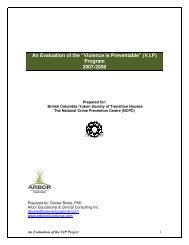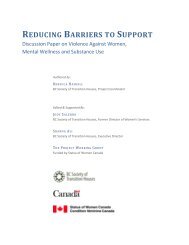a guide to supporting children exposed to domestic violence
a guide to supporting children exposed to domestic violence
a guide to supporting children exposed to domestic violence
You also want an ePaper? Increase the reach of your titles
YUMPU automatically turns print PDFs into web optimized ePapers that Google loves.
CHILDREN NEED GUIDANCE<br />
This includes but is not limited <strong>to</strong> discipline. Remember that you are an important<br />
model for your child, and that your child will be watching and learning from your<br />
behaviour.<br />
• Don’t fall in<strong>to</strong> the trap of giving mixed messages <strong>to</strong> kids, “Do as I say, but not<br />
as I do.” For instance, if you swear a lot, you’ll need <strong>to</strong> s<strong>to</strong>p this if you expect<br />
your <strong>children</strong> not <strong>to</strong> swear.<br />
• Encourage <strong>children</strong>’s positive behaviour. Use consequences such as time-outs<br />
and removal of privileges for negative behaviour.<br />
• Never hit the <strong>children</strong> for punishment. If you spank your child rather than using<br />
non-violent methods of discipline such as time-outs, you may be encouraging<br />
the child <strong>to</strong> hit others.<br />
• If you feel a need <strong>to</strong> spank your child, take a time-out for yourself if you can. A<br />
few minutes alone will give you time <strong>to</strong> calm down. Then deal with your child.<br />
• If you’re feeling guilty about your <strong>children</strong> having been <strong>exposed</strong> <strong>to</strong> <strong>violence</strong>, you<br />
may be tempted <strong>to</strong> make it up <strong>to</strong> them by not disciplining them and not<br />
expecting them <strong>to</strong> do their usual chores. This is likely <strong>to</strong> be a mistake, as<br />
<strong>children</strong> need structure and limits. They need <strong>to</strong> know that a parent is in charge<br />
and that there are some rules and regulations. This makes them feel safe. Have<br />
a clear set of basic household rules, for instance:<br />
◗<br />
No hitting, shoving or pushing.<br />
Sharon’s s<strong>to</strong>ry<br />
Sharon realized that her husband’s occasional, unpredictable <strong>violence</strong> <strong>to</strong>wards her,<br />
the tension in the home, and his irritability with the <strong>children</strong> were causing<br />
difficulties.<br />
The <strong>children</strong> were defiant. They didn’t want <strong>to</strong> eat the meals she prepared, and often<br />
resisted going <strong>to</strong> school. In addition, the 9-year-old was anxious, bit his nails, and<br />
wet the bed. The 7-year-old had nightmares, and the 5-year-old was clingy, cried and<br />
whined frequently, and sometimes went back <strong>to</strong> baby talk.<br />
With the help of a counsellor she and the <strong>children</strong> developed a set of household<br />
rules and posted them on the fridge. Each child had some chores.<br />
Sharon concentrated on praising the <strong>children</strong> for positive behaviour. She talked with<br />
them about the <strong>violence</strong>, said that she’d try <strong>to</strong> keep them safe, and helped them<br />
make safety plans.<br />
HELPING MY CHILD A GUIDE TO SUPPORTING CHILDREN EXPOSED TO DOMESTIC VIOLENCE 39






